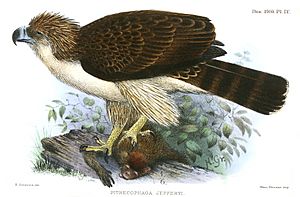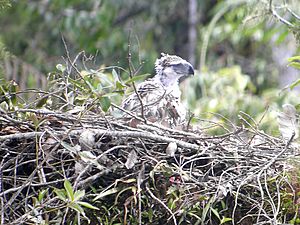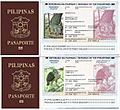Philippine eagle facts for kids
Quick facts for kids Philippine eagle |
|
|---|---|
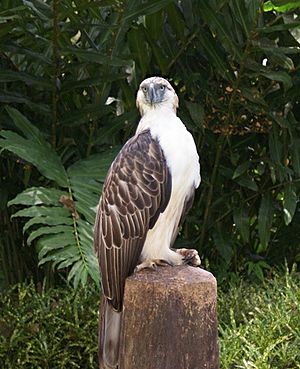 |
|
| Conservation status | |
| Scientific classification | |
| Genus: |
Pithecophaga
|
| Species: |
jefferyi
|
 |
|
| Range in blue | |
The Philippine eagle is a huge bird of prey. It lives only in the forests of the Philippines. People also call it the monkey-eating eagle or great Philippine eagle. This eagle has brown and white feathers. It has a shaggy crest on its head. It can be from 86 to 102 cm (about 3 feet) long. It weighs between 4 and 8 kg (9 to 18 pounds).
It is one of the longest eagles in the world. Its wings are also very wide. The Steller's sea eagle and the harpy eagle are heavier. The Philippine eagle is one of the rarest and strongest birds. It is the national bird of the Philippines. This eagle is critically endangered. This means it is in great danger of disappearing forever. The main reason is that its forest home is being cut down. Philippine law protects these eagles. Harming them can lead to prison time and big fines.
Contents
Discover the Philippine Eagle's Look
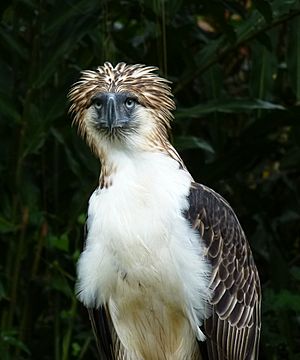
The Philippine eagle has long, brown feathers on its neck. These feathers look like a shaggy mane. Its face is dark, but its neck and head top are creamy-brown. The eagle's back is dark brown. Its belly and the underside of its wings are white.
Its strong legs are yellow. It has large, powerful, dark claws. The eagle's big, curved beak is bluish-gray. Its eyes are blue-gray. Young eagles look like adults. Their top feathers just have lighter edges.
Philippine eagles are usually 86 to 102 cm long. But studies show females are longer than males. Females average 105 cm (about 3.4 feet). This makes them the longest living eagle species. The longest Philippine eagle ever found was 112 cm (about 3.7 feet). This eagle was kept in a zoo. Wild eagles might not grow as large.
These eagles make loud, high-pitched whistles. The sound ends with a change in pitch. Young eagles also make high-pitched calls. They do this when they want food.
Where Philippine Eagles Live
The Philippine eagle lives only in the Philippines. You can find it on four main islands. These are eastern Luzon, Samar, Leyte, and Mindanao. Most eagles live on Mindanao. There are about 82 to 233 breeding pairs there. Only a few pairs live on the other islands.
These eagles live in special forests. They like dipterocarp and mid-mountain forests. They often live in steep areas. They can be found from lowlands up to mountains over 1,800 meters (about 5,900 feet) high. Only a small amount of their old forests are left. This is why they are so endangered.
How Philippine Eagles Live and Behave
Philippine eagles became the top hunters in their forests. This happened because there were no other big predators on the islands. Each pair of eagles needs a very large area to raise their young. This makes them very sensitive to deforestation. If their forest home is cut down, they cannot survive.
These eagles fly fast and are very agile. They fly more like small hawks than other large birds of prey.
Young eagles like to play. They grab tree holes with their talons. They use their tails and wings to balance. They even put their heads into tree holes. They also practice attacking things that are not alive. Sometimes, they hang upside down to improve their balance. Their parents are not around when they do this. So, the young eagles learn to hunt on their own.
Eagles in the wild are thought to live 30 to 60 years. One eagle in a zoo lived for 41 years. Another lived for 46 years. But wild birds usually live shorter lives than those in zoos.
What Philippine Eagles Eat
The Philippine eagle was first called the "monkey-eating eagle." People thought they ate only monkeys. But this is not true. Like most predators, they eat what is easiest to find. They are the top predator in their home.
Eagles eat prey of many sizes. They can eat a small bat weighing 10 grams (0.35 ounces). They can also eat a Philippine deer weighing 14 kg (31 pounds). What they eat most depends on the island. For example, Philippine flying lemurs are a favorite food in Mindanao. But flying lemurs do not live in Luzon.
In Luzon, eagles mainly eat monkeys and birds. They also eat flying foxes and giant cloud-rats. They hunt reptiles like large snakes and lizards. Flying lemurs can make up 90% of their diet in some places. Eagles will eat almost any animal in the Philippines. They do not usually hunt adult large animals or humans. They also eat Asian palm civets, flying squirrels, and rats. Sometimes, they even eat other birds of prey. They have been seen catching young pigs and small dogs.
Philippine eagles use two main ways to hunt. One is "still-hunting." They sit very still on a branch. They watch for prey below. The other way is "perch-hunting." They glide from one perch to another. They often move down from the top of the trees. If they do not find prey, they fly back up to the top. Then they start again.
The Philippine Eagle Life Cycle and Reproduction
The Philippine eagle's breeding cycle takes two years. Like most eagles, they have only one mate for life. If one eagle dies, the other will often find a new mate.
Courtship starts when they begin building a nest. The eagles stay close to their nest. They also do special aerial displays. The male might chase the female in a dive. They might present their talons to each other in mid-air. They also make loud calls. An eagle shows it is ready to breed by bringing nesting materials to the nest. Courtship can start as early as July.
The breeding season is in July. Eagles on different islands might start breeding at different times. The amount of rain and food can also change the season. The nest is usually built in a very tall tree. These trees are often in old or disturbed forests. Nests are lined with green leaves. They can be about 1.5 meters (5 feet) wide. The nest is usually 30 meters (100 feet) or more above the ground. Like other large birds of prey, their nest looks like a huge platform of sticks.
Eagles often use the same nest site for many years. About 8 to 10 days before laying an egg, the female feels "egg lethargy." She does not eat much. She drinks a lot of water. Her wings droop. The female usually lays one egg in the late afternoon. Sometimes, two eggs are laid. If an egg does not hatch, the parents might lay another egg the next year. The egg hatches after 58 to 68 days. Both parents help keep the egg warm. But the female does most of it.
Both parents feed the new eaglet. They also take turns protecting the eaglet from sun and rain. They do this until the eaglet is about seven weeks old.
Protecting the Philippine Eagle

In 1994, experts said the Philippine eagle was critically endangered. This means it is very close to disappearing. In 2015, only about 600 eagles were left in the wild. The Zoological Society of London said it was one of the most unique and endangered species in the world.
The biggest threat to these eagles is deforestation. Forests are being cut down for logging and farms. Mining, pollution, and pesticides also harm them. Sometimes, eagles get caught in traps meant for deer. In the past, eagles were also caught for zoos.
People started noticing the eagles' low numbers in 1965. Charles Lindbergh, a famous pilot, helped protect the eagle. He worked with the World Wide Fund for Nature. He helped convince the Philippine government to protect the eagle. In 1969, a program started to save the species.
The first Philippine eagles were hatched in captivity in 1992. This was done using artificial methods. The first eagle born naturally in captivity was in 1999. In 2004, an eagle named Kabayan was released into the wild. But it died in 2005. Another eagle, Kagsabua, was released in 2008. Sadly, a farmer shot and ate it. In 2015, another eagle was released after being treated for a gunshot wound. Two months later, it was also shot and killed. Killing this endangered bird is against Philippine law. It can lead to 12 years in jail and big fines.
The number of eagles has slowly gone down. Floods and mudslides, caused by deforestation, have also hurt the remaining eagles. The Philippine eagle might soon disappear from the wild. People need to act now to save them.
The Philippine Eagle Foundation in Davao City helps protect these eagles. They also work to save their forest homes. The foundation has successfully bred eagles in captivity for many years. They have also released some into the wild. The foundation has 36 eagles at its center. Nineteen of these were born there.
Scientists are still studying the eagles. They learn about their behavior, how they live, and their numbers. Some protected areas have been made just for these eagles. But many eagles still live in unprotected areas.
Related pages
Images for kids
See also
 In Spanish: Águila monera para niños
In Spanish: Águila monera para niños



